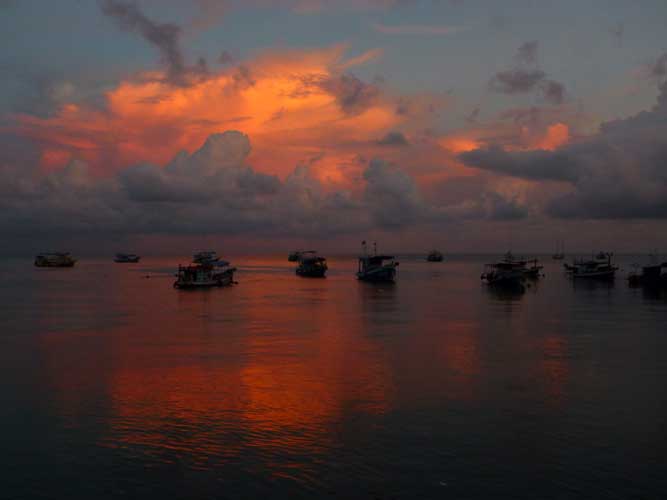
Clouds light up at sunrise.
We are the first dive boat out of Koh Tao's harbor and will be first to reach Chumphon Pinnacle.
I joined backpackers for a leisurely 2.5-hour boat ride on the Songserm Express north to Koh Tao, famed for the best diving in the Gulf of Thailand. Diving costs are among the lowest in the world, another attraction for me. In 2007, at the end of an epic bicycle ride, www.crazyguyonabike.com/doc/asiaoneyear, I came to Koh Tao for the first time and got recertified by taking the Open Water and Advanced Open Water scuba courses at New Way Diving, www.newwaydiving.com/, which I have been going back to most years since. One of the staff met me near the pier and we drove north a few kilometers to Sairee Beach, a long stretch of sand with many bungalows, restaurants, and diving outfits.
I made six dives over the next three days, enjoying the multitude of colorful undersea life in the very warm and transparent tropical water. As I hadn't been diving for a year and a half, I started with a Scuba Review of theory and safe diving practices at the dive shop, then out to the Twins dive site and doing skills like clearing a flooded mask. That out of the way, there was still time for a dive in the warm water (30 degrees Celsius) at depths up to about 13 meters, followed by another shallow dive at Japanese Gardens, both close to the little island of Koh Nangyuan, just northwest of Koh Tao. Creatures included a blue-spotted stingray, white-eyed moray eel, six-banded and blue-ringed angelfish, yellow butterfly fish, titan triggerfish (notorious for being very territorial), Boer's batfish, and lots of vari-colored Christmas tree worms. A scribbled filefish swam in a vertical, nose-down position, which looked odd, but no doubt the fish knew what it was doing.
Very early the next morning we headed farther out to Chumphon Pinnacle, one of the most popular dive sites for its sheer numbers of fish; we saw giant grouper, lots of yellow-fin trevally, boxer and Durban dancing shrimp, and many schools of small fish. Visibility ranged up to 25 meters, quite good. Later that morning we dived a bit shallower at White Rock, seeing a very toxic and well camouflaged scorpion fish as well as many more colorful species.

Clouds light up at sunrise.
We are the first dive boat out of Koh Tao's harbor and will be first to reach
Chumphon Pinnacle.

Out at sea, this owl takes a break atop our boat's antenna!

Lefaure David, from France, is leading the Chumphon Pinnacle dive for several of
us. He tends to be very demonstrative,
but here he's just reviewing the sign for "low on air," that we should use if
our air tank gets down to 50 bar, about one-quarter full.
The following morning we got an even earlier start for the long trip out to Sail Rock, a tiny barren piece of rock that rises out of the sea about half way between Koh Tao and Koh Phangan. It's famed as the best dive site of the region, but is so far out that dive boats go just once a week at most. We did two dives here, enjoying visibility upwards of 40 meters, and lots of fish, including a streamlined one-meter-long king mackerel. Even slimmer, crocodile needlefish hung out near the surface. Giant grouper lazed on rock ledges and a giant moray eel the size of your leg kept to a crevice. Other notables included the titan triggerfish, six-banded and blue-ringed angelfish, butterfly fish, and longfin bannerfish. But what everyone dreamed of seeing is the relatively rare whale shark (Rhincodon typus), a harmless filter feeder monster that's the largest extant fish species; see https://en.wikipedia.org/wiki/Whale_shark. While we were on the boat between the two dives, other divers reported a whale shark, and after a bit of skepticism, our boat emptied fast. Some of our group caught up with the whale shark but I missed it.
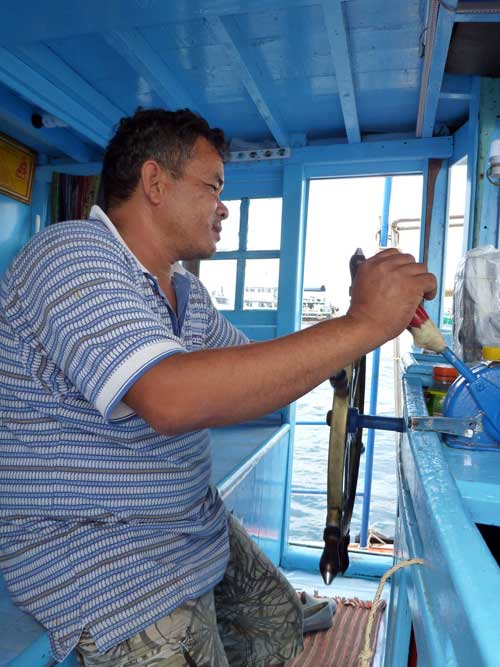
Our captain

Devoid of vegetation, Sail Rock lacks charm above water, but holds much sea
life below.

We have two serious videographers on board.
One of our group, Andrew from South Africa and lately living in London, had picked up an underwater camera housing in Bangkok and got some good photos of Sail Rock diving. He let me copy them, so you can see the sea life too!

Hi! That's me and everything is OK. We've just started the descent on our first
dive, during which we went as deep as 24 meters.
I'm holding the buoyancy control in my left hand, as I need to add a bit of air
to my BCD (Buoyancy Compensation Device)
to compensate for the compression of
the wet suit at deeper depths. That's a spare regulator on my right chest.
Gauges near my waist give depth and amount of air left in the tank, out of sight
behind me.
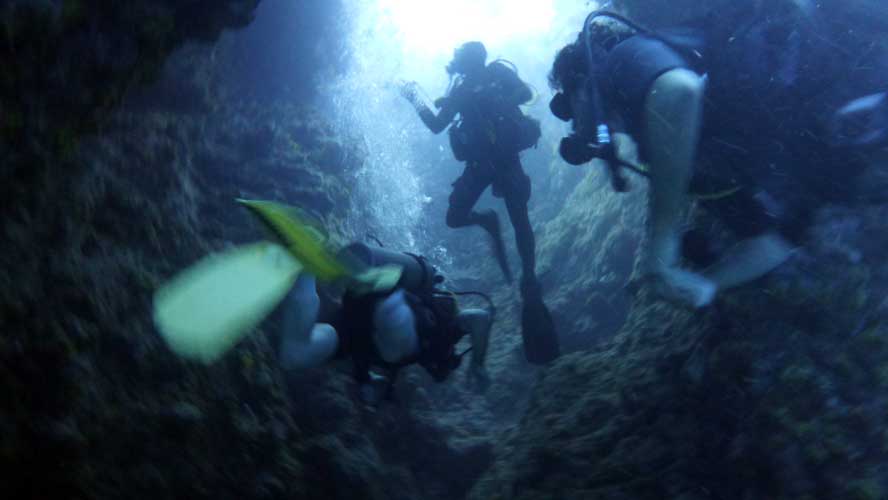
For fun, we ascended this chimney from a depth of about 20 meters, then exited
at 5 meters and continued our dive.

A gorgonian or sea fan coral, and quite a few fish

A malabar grouper (Epinephelus malabaricus)
With that big mouth, it can vacuum up any small fish that come close.

I think these are streaked spinefoot (Siganus javus), a species of
rabbitfish.
Like all rabbitfish, it has venomous spines on the dorsal, anal and pelvic fins.
It is a herbivore,
feeding mostly on algae in shallow coastal waters, brackish lagoons, and rocky or
coral reefs. (Wikipedia)

A rockfish hangs out among the anemones, corals, and clams in this scene.

Whale Shark!
I don't know what the red bits in the water are; perhaps a flash was used in
this photo, capturing bits of organic debris.
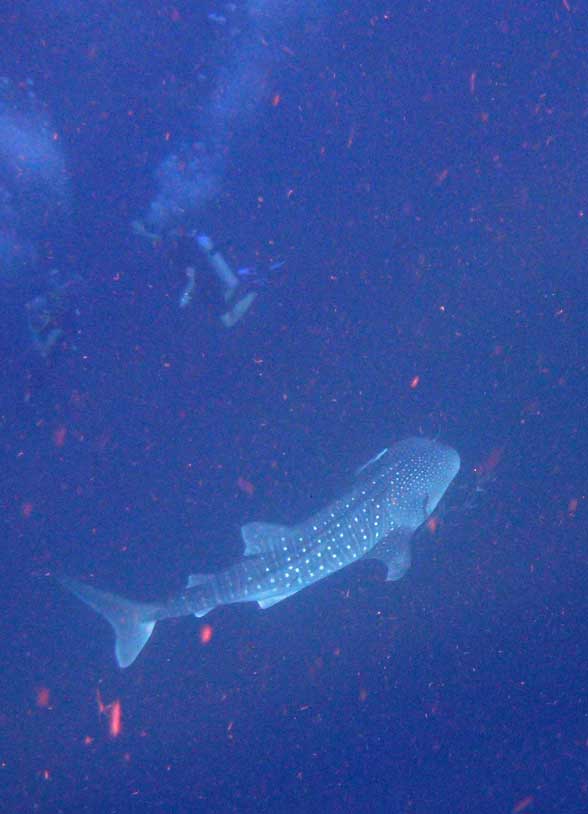
These lucky divers were in the right place at the right time!

A beautiful scene from our second dive at Sail Rock

A black-spotted porcupine fish (Diodon hystrix), a large pufferfish; it's
found throughout the tropics in the Atlantic, Pacific, and Indian Oceans.
Here
one gets a grooming from a cleaner wrasse, which eats parasites and dead tissue
off larger fishes' skin in a mutualist relationship
that provides food and
protection for the wrasse, and considerable health benefits for the other fish.
Divers also get the same service, especially if there's dead skin to be had.

A pair of malabar groupers (Epinephelus malabaricus)

Sometimes the best views underwater are looking back up to the surface.

I think this is a species of grouper; the fish just stands around around waiting
for dinner to come to it.

It's not easy to look romantic in scuba gear, but Andrew and Tamryn are on a
diving vacation in Asia.

As it's a long day to Sail Rock and back, two hours each way, we get lunch after the dives.
On the way back to Koh Tao after the Sail Rock dives, I felt a slight pain in my right ear canal. The discomfort gradually became worse overnight, so I saw a doctor the next morning. I had a case of swimmer's ear, and was given penicillin tablets and ear drops along with the advice not to dive for a week, or maybe at best three days. Koh Tao had little attraction for me other than diving, and the weather was very hot, so I considered leaving. Instead I hung around a couple more days and worked on this website and other Internet stuff, hoping that the ear infection would heal quickly. It did, and I was back in the water two days later for shallow dives at Mango Bay on Koh Tao's north shore and Twins just off Koh Nangyuan. Colors are brightest at shallow depths, and I saw many Christmas tree worms, feather-like spiral fronds of many colors than can disappear back into a tiny tube in a flash if danger threatens. Many fish swam about, such as aptly named batfish, porcupine pufferfish, crocodile needlefish, and titan triggerfish. White-eyed moray eels hung out in crevices waiting for a fishy morsel to swim by. My ear was fine, and I got in a total of 19 dives off Koh Tao.
Last year the Sattakut, a retired Thai navy ship, had been sunk just west of Koh Tao as a dive site. During World War II it had served as USS LCI-739 with the U.S. navy and earned three battle stars for operations in the Western Caroline Islands (southern Palao Islands) in Sept.-Oct. 1944, Iwo Jima in Feb.-March 1945, and Okinawa Gunto in March-June 1945. It lay at about 25 meters down and was still in excellent condition, though had little life growing on it's surfaces. Tiny fish had made their homes in the bow, as screened portholes prevented entry of predators. After taking a leisurely look, we swam to shallower depths of Hin Pee Wee, a small jumble of boulders with abundant fish and corals. Anna and Jim of New Way Diving had a camera along on this and several subsequent dives, and they shared the photos below.

A fish's eye view of our dive boat at Sattakut dive site.

The Sattakut's guns have gone silent forever.
In the evening, after the Sattakut dive, I went out to White Rock for a night dive, entering the black waters about sunset. Underwater life is different at night, just as terrestrial life is. We discovered a titan triggerfish snoozing in a crevice, and we could get much closer to it than during the day. We also saw an Indian walkman, a highly poisonous scorpionfish that really does "walk" across the seafloor on its fins.
Another opportunity to visit Sail Rock came up, so I joined the group for two more great dives there. No whale shark this time, but we saw a huge number and variety of fish and other creatures. Jim, just ahead of me, saw an octopus slithering along, then into a crevice; all I could see was its eye because it had changed color to perfectly match its surroundings.

Two cleaning wrasse service a longfin batfish (Platax teira) at Sail Rock.

Varicose wart slugs may be sluggish, but they're pretty despite their name. (Sail Rock)
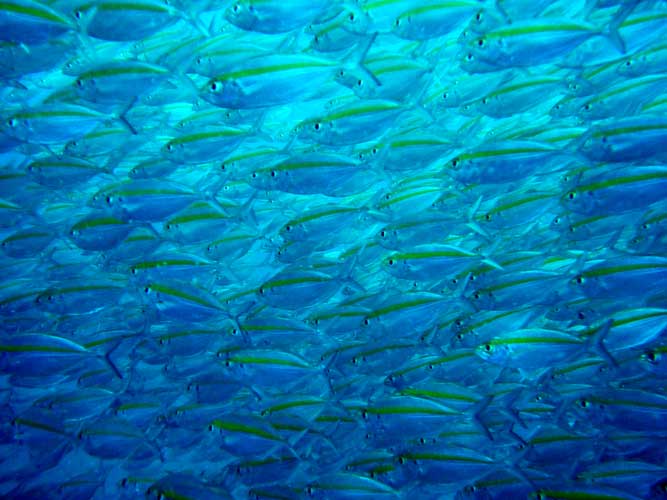
I think these are yellowstripe scad (Selaroides leptolepis). (Sail Rock)

Yellowtail barracuda (Sphyraena flavicauda) at Sail Rock; they are small and harmless to divers.

Titan triggerfish (Balistoides viridescens) at Sail Rock
Females guarding a nest can be very territorial and will try to chase away or
even bite divers. If its first dorsal spine becomes erect, that's a warning!
The
diver's defense is to swim away keeping close to the bottom and use one's fins
to fend off the fish.
On my last day, our boat headed around to a pair of seldom dived destinations on the northeast side of Koh Tao. Hin Wong Pinnacle had an incredible variety of things to see and very good visibility, 20 meters plus. We saw far more fan and other soft corals than any other dive site in the area. A small school of grooved razorfish were strangest of all because these very slender small fish swam nose down in a vertical position.

Divers delight in seeing a nudibranch, one of the
most beautiful and strangest looking of sea creatures.
The name comes from
the Latin nudus, ‘naked,’ and the Greek brankhia, ‘gills,’
which you can see here.
A flashlight brings out the yellow at Hin Wong
Pinnacle.

Hawksbill sea turtle (Eretmochelys imbricata) at Hin Wong Pinnacle
Koh Tao is Thai for "Turtle Island" and although the island is shaped a bit like
a turtle, sea turtles are a rare sight.

A scribbled filefish (Aluterus scriptus) at Hin Wong Pinnacle
This fish tends to move slowly by undulating the translucent fins on the top and
bottom; sometimes it swims vertically, head down.
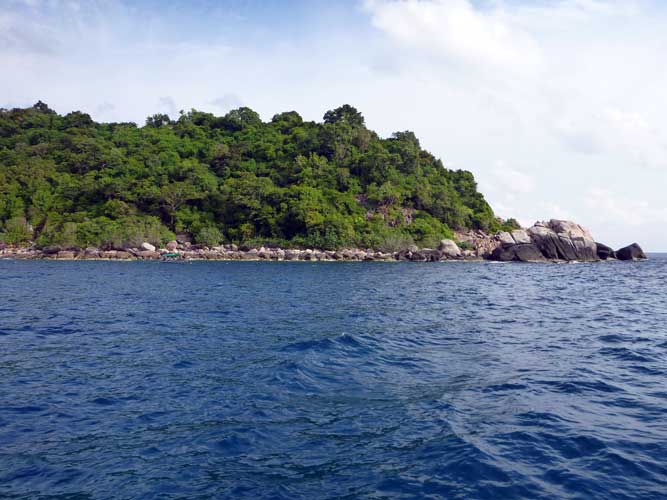
From Hin Wong Pinnacle, we moved just a bit north to Lighthouse Bay dive site, named for a little lighthouse just out of
sight atop this ridge.
This northeast corner of Koh Tao has very little development; some people are
camped here near the shore.

We're changing tanks after the Hin Wong Pinnacle dive in preparation for the
Lighthouse Bay dive.
One tank lasts about 40 minutes at deep dives such as Chumphon Pinnacle and
upwards of 60 minutes at shallower sites.
We managed to stay down about 60 minutes at both Hin Wong Pinnacle (22 meter
depth) and Lighthouse Bay (18 meters depth).